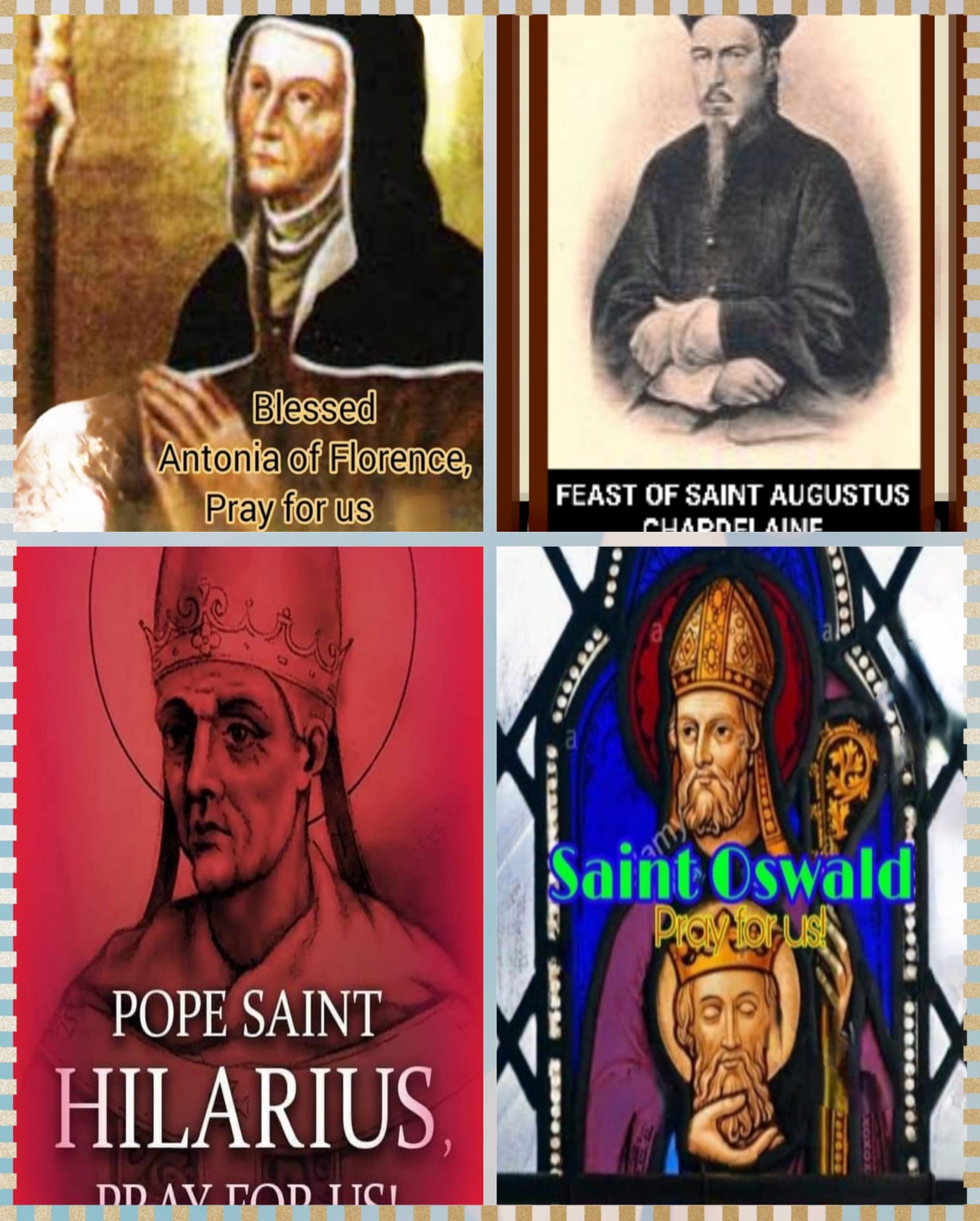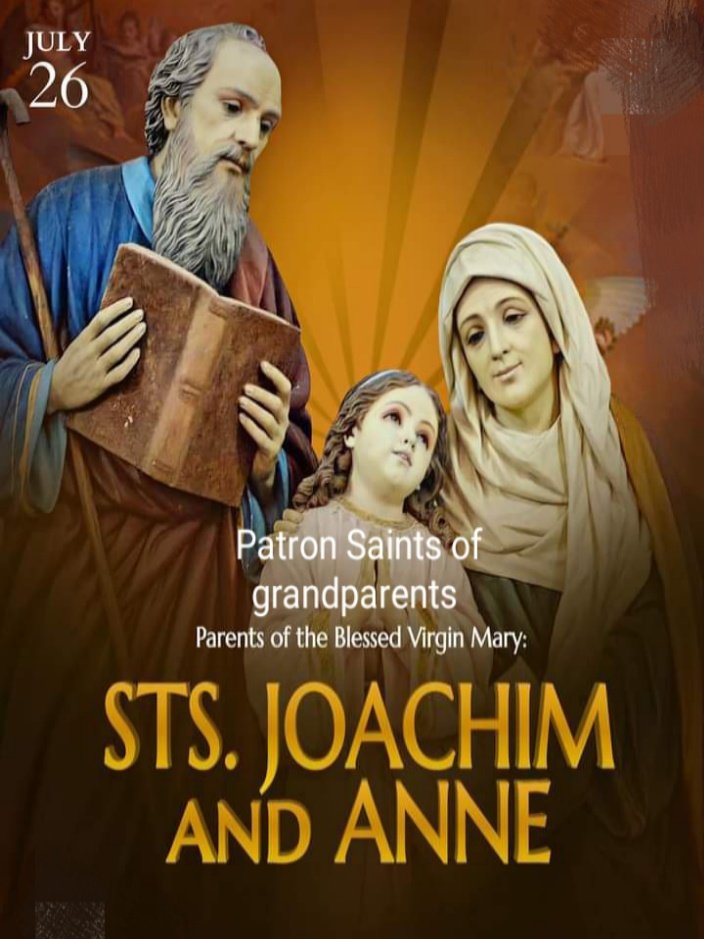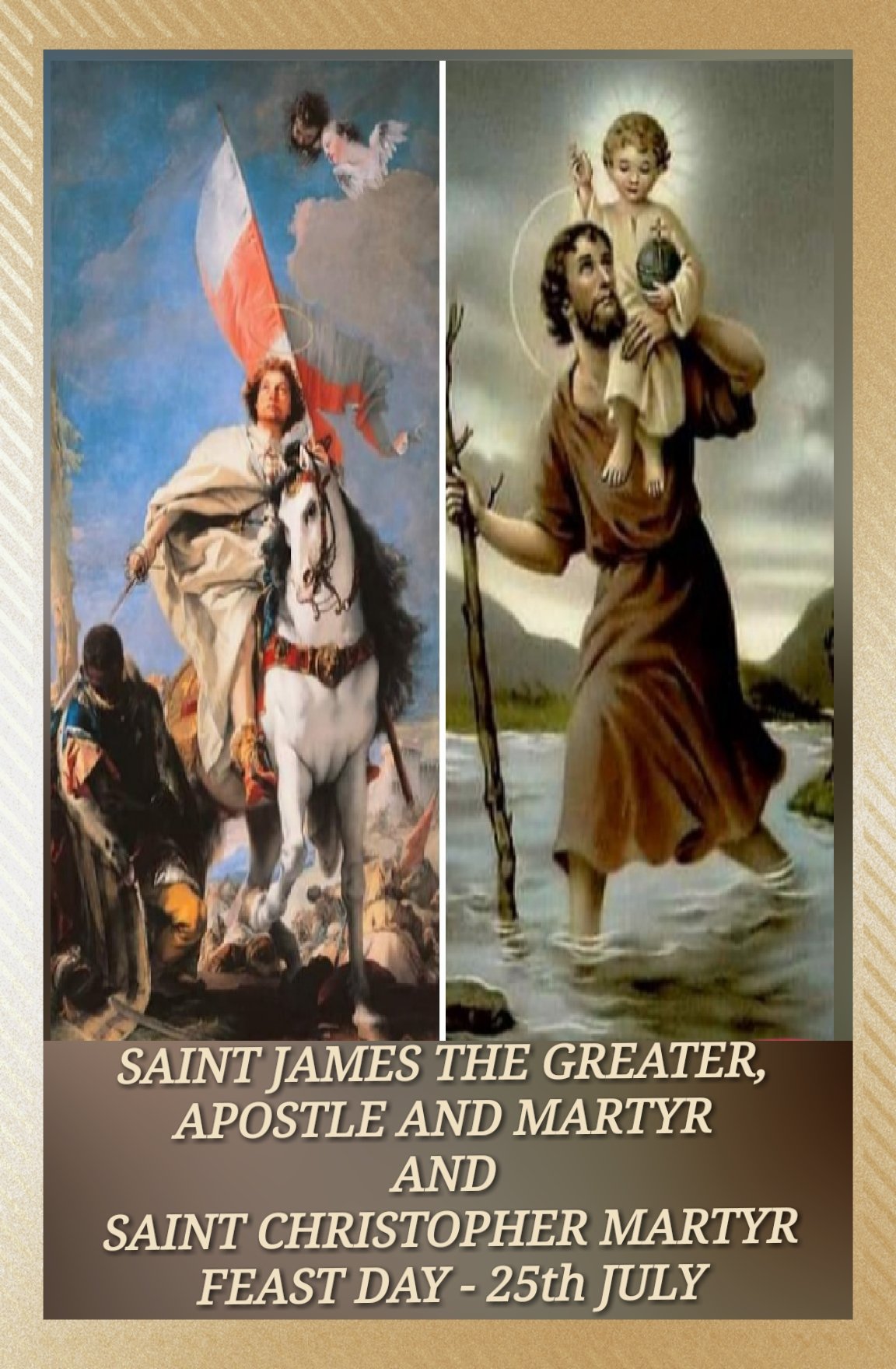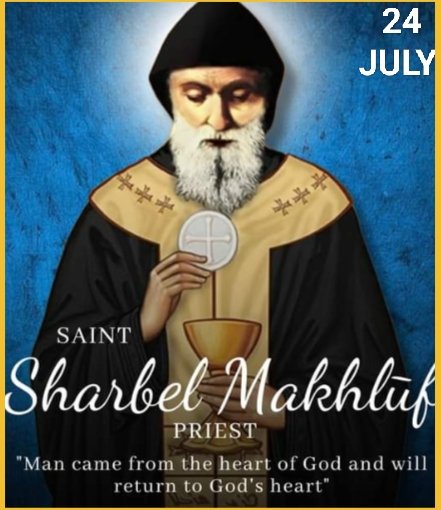
MONTHLY DEVOTIONAL FOR 28th FEBRUARY
February 28, 2024
Psalm 139: 23-24
February 29, 2024FEAST OF BLESSED ANTONIA OF FLORENCE, AUGUSTUS CHAPDELAINE, SAINTS HILARY, POPE AND OSWALD OF WORCESTER – 29 FEBRUARY
FEAST OF BLESSED ANTONIA OF FLORENCE – 29 FEBRUARY

Beloved, Antonia of Florence was from a noble family that lived in Florence, Italy in 1400. She got married at an early age obeying her parents though this was due to the wish of her parents.
Unfortunately, her husband died in 1428, but she allowed nothing to persuade her into agreeing to a second marriage but decided to withdraw from the world and start living for God and the salvation of her soul.
She entered the convent of tertiaries in the following year with blessed Angelina. At Florence, she distinguished herself by virtue and wisdom, that after a few years the senior called her to Foligno to chair as a superior of the convent there.
Antonia is said to have had remarkable patience and humility, for she bore without complaint a very painful illness for more than 15 years.
She was the head of the Abbey of nuns at Aquila in Italy from 1433 to 1447. She was the founder of an Observant-oriented house of Poor Clares, also in Aquila.
Her spiritual director was John of Capistrano. Antonia died on 29 February 1472. Many miracles occurred at her tomb and her body has remained incorrupt. She was beatified by Pope Pius IX.[5] in 1847.
Her Feast Day is celebrated on 29 February (in leap years), 28 February (in non-leap years).
PRAYER
Blessed Antonia of Florence, you knew the trouble of family problems and led others in the search for holiness. Help us to discover our true call and to embrace it with all our hearts. Through Christ our Lord. Amen.
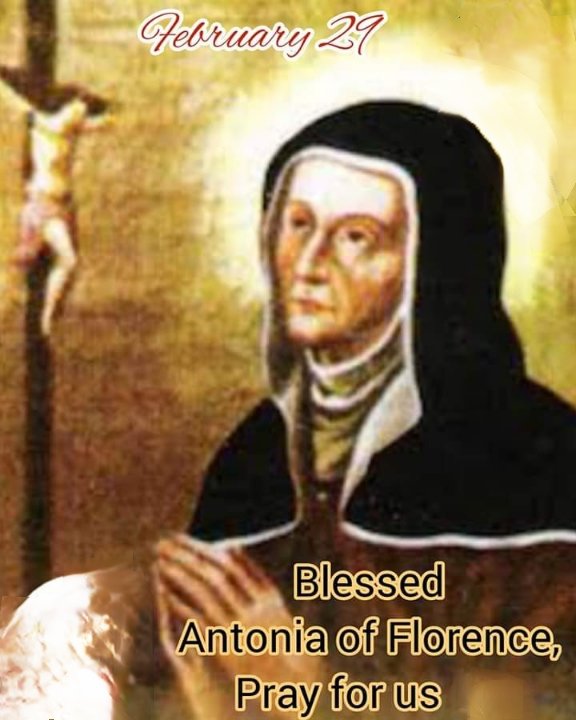
Blessed Antonia of Florence, Pray for us.
**************************************
SAINT AUGUSTUS CHAPDELAINE
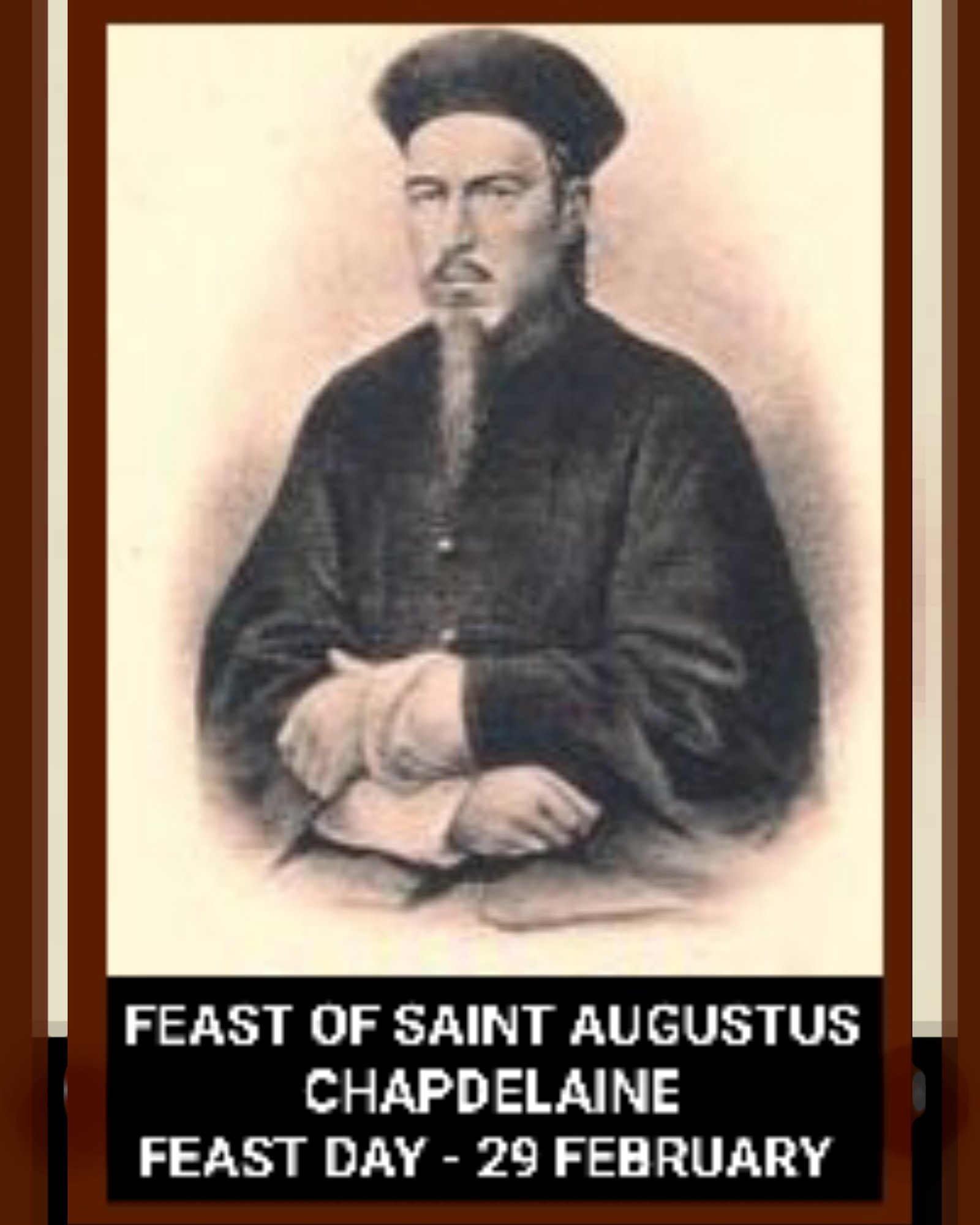
Auguste Chapdelaine, Chinese name Mǎ Lài, (6 February 1814 – 29 February 1856) was a French Christian missionary of the Paris Foreign Missions Society. France used his death–– Chapdelaine was executed by Chinese officials–– as a casus belli for its participation in the Second Opium War.
Chapdelaine was born on a farm in La Rochelle-Normande, France. By the age of twenty, he had entered the seminary at Coutances. He was ordained a priest in 1843 and in 1851 joined the Institute of Foreign Missions in Paris. He left from Antwerp in April 1852 to join the Catholic mission in the Guangxi province of China. The Taiping Rebellion led to suspicion of Christians and foreigners were forbidden to enter the area.
After a stay in Guangzhou, he moved to Guiyang, capital of the Guizhou province, in the spring of 1854. In December, he went, together with Lu Tingmei, to Yaoshan village, Xilin County of Guangxi, where he met the local Catholic community of around 300 people. He celebrated his first mass there on 8 December 1854. He was arrested and thrown into the Xilin county prison ten days after his arrival and was released after sixteen or days of captivity.
Following personal threats, Chapdelaine returned to Guizhou in early 1855, and came back to Guangxi in December of the same year. He was denounced on February 22, 1856, by Bai San, a relative of a new convert, while the local tribunal was on holiday. He was arrested in Yaoshan, together with other Chinese Catholics, by orders of Zhang Mingfeng, the new local mandarin on 25 February 1856.
Chapdelaine was accused of stirring up insurrection and refused to pay a bribe. Condemned to cage torture (zhanlong), he was first beaten one hundred times on the cheek by a leather thong, which caused his teeth to fly out, his face mutilated, and his jaw lacerated. He was locked into a small iron cage, which was hung at the gate of the jail.
The planks he stood on were gradually removed, placing a strain in the muscles of the neck, and leading to a slow and painful death from suffocation. He had already died when he was decapitated. His head was hung from a tree by his hair. Children were said to have thrown stones at the head until Chapdelaine’s head fell to the ground and was devoured by street dogs and hogs.
Chapdelaine was beatified in 1900. He was canonized on 1 October 2000, by Pope John Paul II, together with 120 Christian martyrs who had died in China between the 17th and 20th centuries.
PRAYER
All-powerful, ever-living God, turn our weakness into strength. As you gave Augustine Zhao Rong/ Augustus Chapdelaine and the martyrs of China the courage to suffer death for Christ, give us the courage to live in faithful witness to you.
Grant this through our Lord Jesus Christ, your Son, Who lives and reigns with you and the Holy Spirit, one God, for ever and ever. Amen.

Saint Augustus Chapdelaine, pray for us.
**************************************
SAINT HILARIUS/ HILARY, POPE

Saint Hilary was Pope for 7 years during the 5th century. Pope Hilarius, as he was known, (also Hilarus, Hilary; died 29 February 468) was the bishop of Rome from AD 461 to 468.
Before becoming pope, he worked on an updated method of calculating the date of Easter. As pope, he confirmed the work of several general councils, rebuilt and remodeled many churches, and fought Nestorianism and Arianism. He was known for defending the rights of his bishops while exhorting them to curb their excesses and devote themselves more completely to God.
In 449, Hilarius served as a legate for Pope Leo I at the Second Council of Ephesus. His opposition to the condemnation of Flavian of Constantinople incurred the enmity of Dioscurus of Alexandria, who attempted to prevent him from leaving the city. Hilarius was able to make his escape and returned to Rome by an indirect route. He later erected an oratory at the Lateran in honor of John the Evangelist, to whom he attributed his safe passage.
Much of his pontificate was spent in maintaining ecclesiastical discipline in conformity with canon law, and in settling jurisdictional disputes among the bishops of both Gaul and Spain.
As pope, he continued the policy of his predecessor, Leo I, who, in his contest with Hilary of Arles, had obtained from Emperor Valentinian III a famous rescript of 444 (called Novel 17) confirming the supremacy of the bishop of Rome.[6] Hilarius continued to strengthen ecclesiastical government in Gaul and Spain.
In Rome, Hilarius worked zealously to counter the new emperor’s 467 edict of toleration for schismatic sects, which had been inspired, according to a letter of Pope Gelasius I, by a favourite of Emperor Anthemius named Philotheus, who espoused the Macedonian heresy. On one of the emperor’s visits to St Peter’s Basilica, the pope openly called him to account for his favourite’s conduct, exhorting him by the grave of St Peter to promise that he would allow no schismatical assemblies in Rome.
Hilarius died on 29 February 468 and was buried in Basilica of St. Lawrence outside the Walls.
PRAYER
O Lord our God, you raised up your servant Hilary to be a champion of the catholic faith: Keep us steadfast in that true faith which we professed at our baptism, that we may rejoice in having you for our Father, and may abide in your Son, in the fellowship of the Holy Spirit; who live and reign for ever and ever. Amen.
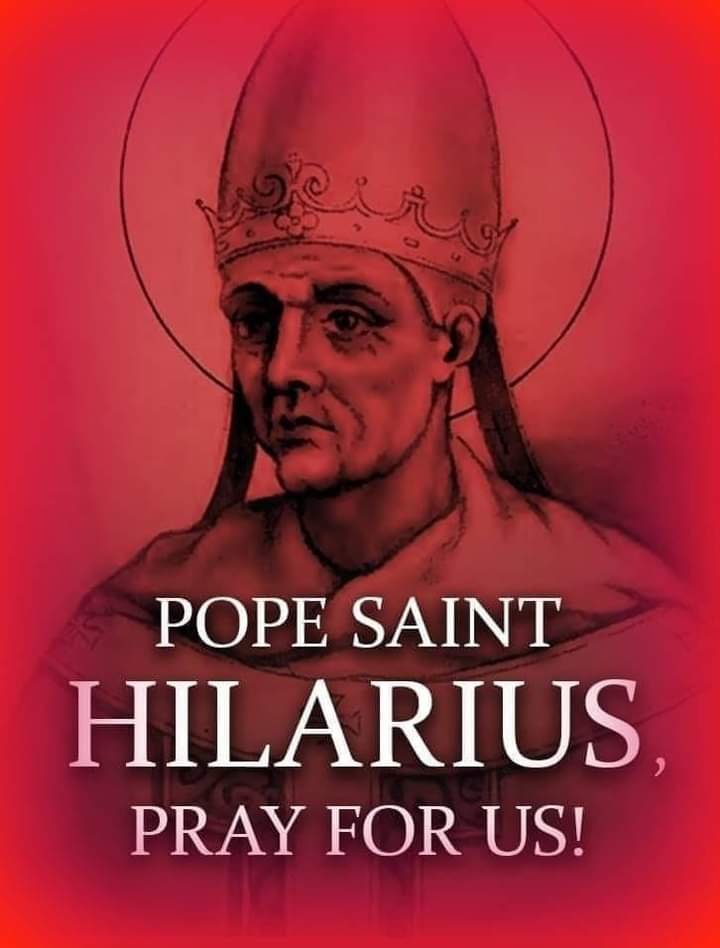
Saint Hilary, pray for us!
***************************************
SAINT OSWALD OF WORCESTER

Oswald of Worcester (died 29 February 992) was Archbishop of York from 972 to his death in 992. He was of Danish ancestry, but brought up by his uncle, Oda, who sent him to France to the abbey of Fleury to become a monk. After a number of years at Fleury, Oswald returned to England at the request of his uncle, who died before Oswald returned.
With his uncle’s death, Oswald needed a patron and turned to another kinsman, Oskytel, who had recently become Archbishop of York. His activity for Oskytel attracted the notice of Archbishop Dunstan who had Oswald consecrated as Bishop of Worcester in 961. In 972, Oswald was promoted to the see of York, although he continued to hold Worcester also.
As bishop and archbishop, Oswald was a supporter and one of the leading promoters (together with Æthelwold) of Dunstan’s reforms of the church, including monastic reforms. Oswald founded a number of monasteries, including Ramsey Abbey, and reformed another seven, including Winchcombe in Gloucestershire and Pershore and Evesham in Worcestershire. Oswald also switched the cathedral chapter of Worcester from secular clergy to monks. While archbishop, he brought the scholar Abbo of Fleury to teach, and he spent two years in England, mostly at Ramsey. Oswald died in 992, while washing the feet of the poor. A hagiographical life was written shortly after his death, and he was quickly hailed as a saint.
Oswald died on 29 February 992 in the act of washing the feet of the poor at Worcester, as was his daily custom during Lent, and was buried in the Church of St Mary at Worcester. He promoted the education of the clergy and persuaded scholars to come from Fleury and teach in England. A Life of Oswald was written after his death, probably by Byrhtferth, a monk of Ramsey Abbey. Two manuscripts, a psalter (Harley MS 2904 in the British Library) and a pontifical (MS 100, part 2 from Sidney Sussex College of Cambridge University), probably belonged to Oswald and would have been used in his daily devotions.
Almost immediately after his death miracles were reported at his funeral and at his tomb. His remains were translated to a different burial spot in Worcester Cathedral ten years after his death. His feast day is celebrated on 28 February or on 19 May in the Personal Ordinariate of the Chair of Saint Peter. On leap years, it is celebrated on 29th February.
St. Oswald is the patron saint of soldiers. He always took a cross into battle with him and prayed at the foot of the cross to ask God to protect him and his soldiers.

PRAYER
O glorious Oswald, ruler of faith and model of meekness, splendour of Worcester and luminary of York, like a tree in the midst of paradise didst you bear the fruit of the virtues for your Lord.
Enlighten all who cherish your honoured memory as we ever cry out to you in prayer. Intercede, O holy bishop, that our souls may be saved. Amen

Saint Oswald of Worcester, pray for us.

